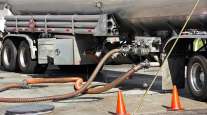Senior Reporter
Diesel Prices Down 2.5¢ to $3.897 a Gallon

[Stay on top of transportation news: Get TTNews in your inbox.]
Diesel prices dipped 2.5 cents on average to drop below $3.90 a gallon, according to Energy Information Administration data released May 15.
Diesel’s price settled at an average of $3.897, the first time it has been below $3.90 a gallon since it was $3.846 on Jan. 31, 2022. The average price has fallen 72.5 cents a gallon since Jan. 30.
Trucking’s main fuel fell in price in all 10 regions in EIA’s weekly survey, ranging from a high of 13.1 cents a gallon in the New England area to four-tenths of a cent in the Midwest region.
The national average price for gasoline rose, but by just three-tenths of a cent. It sits at $3.536 a gallon, down by 95.5 cents from a year ago.

EIA.gov
FGE Energy Consultant Krista Kuhl told Transport Topics there are several reasons why diesel prices have been falling and gasoline prices are remaining stable, even as the summer driving season nears its peak.
“As far as prices go, a warm winter — lowering demand for heating oil — resulted in U.S. diesel prices to begin falling months ago,” Kuhl said. “If you look at the differential between pump prices for gasoline and pump prices for diesel in the U.S., it’s finally narrowing back to more normal levels after surging early last year after Russia’s invasion of Ukraine.”
With the price of oil declining and the benchmark West Texas Intermediate crude now trading at just over $70 a barrel and down from $99 a barrel a year ago, the U.S. Energy Department announced this week it will begin refilling the nation’s Strategic Petroleum Reserve, which the Biden Administration tapped last year when oil, gasoline, diesel and jet fuel prices were soaring in the aftermath of Russia’s invasion of Ukraine.
U.S. average retail prices for May 15, 2023:
Regular grade #gasoline: $3.54/gal
On-highway #diesel: $3.90/gal #gasprices https://t.co/dsfxiPA8Wj — EIA (@EIAgov) May 15, 2023
The administration announced in March 2022 it would release 1 million barrels a day from the Strategic Petroleum Reserve over the following six months, for a total 180 million-barrel drawdown.
The SPR held about 638 million barrels of oil when President Joe Biden took office in January 2021, according to the US Energy Information Administration. Today, it is down to 362 million barrels, the lowest level since October 1983. That’s about 20 days of available oil under current U.S. consumption rates.
And the drawdown angered some Republicans, who charged the administration was playing politics with the nation’s oil supply and leaving too little oil in reserve in the event of a national emergency.
In this initial purchase, the Energy Department says it will seek 3 million barrels of what’s called sour crude oil. That type is considered dirtier, containing higher levels of sulfur, and more difficult and expensive to refine. It often is made into diesel or heating oil.

Chad Crotty of DDC FPO Solutions discusses how fleets handle outsourced business services. Tune in above or by going to RoadSigns.ttnews.com.
“DOE is committed to executing an SPR replenishment strategy that provides the best deal for taxpayers — aiming to repurchase crude at a lower price than the average of about $95 per barrel it was sold for in 2022 while strengthening energy security by providing certainty to the industry in a way that helps encourage near-term supply,” the department said in a statement. DOE also said it plans to purchase more oil at an unspecified date later in the year.
Last October, the White House announced it would begin buying oil to replenish the SPR once prices fell to a range of $67 to $72 a barrel.
The nation’s Big Hill Oil Reserve in Winnie, Texas, just west of the Texas-Louisiana border will be the first of the SPR’s four major Gulf Coast sites to begin receiving oil.
The sites, two in Texas and two in Louisiana, are capable storing more than 700 million barrels.
As for the Memorial Day weekend, automobile group AAA says the unofficial beginning of summer will be the busiest in years with 42.3 million Americans traveling 50 miles or more from home, a 7% increase over last year.
“This is expected to be the third-busiest Memorial Day weekend since 2000,” Paula Twidale, senior vice president of AAA Travel, said in a statement. “This summer travel season could be one for the record books, especially at airports.”
AAA said nearly 3.4 million people will take to the skies over the holiday, up 11% from 2022 and 5.4% from 2019.
AAA projects 42.3 million Americans will travel Memorial Day weekend. Air travel is set to surpass pre-pandemic numbers. All signs point to a VERY busy summer travel season ahead. @AAA_Travel https://t.co/LX88BMt13m — AAA (@AAAnews) May 15, 2023
Personal vehicle travel will be up 6% from the same period in 2022 as AAA projects 37.1 million Americans will hit the roads over Memorial Day weekend — a 6% increase from last year.
Drivers also will see lower gas prices heading into the holiday weekend, down more than 50 cents a gallon from last year when the average price topped $4.
Want more news? Listen to today's daily briefing below or go here for more info:




